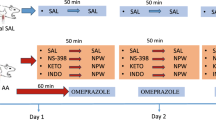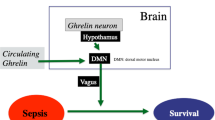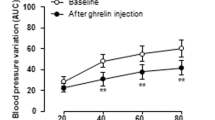Abstract
The mechanisms by which transforming growth factor-α (TGF-α) protects the stomach against mucosal injury are incompletely understood. The aim of this study was to examine the roles of sensory neurons, sensory neuropeptides and prostaglandins in TGFα gastroprotection against ethanol. Fasted rats received TGF-α (50 μg/kg, intraperitoneally) prior to orogastric ethanol (75% v/v, 1 ml). Gastric injury was quantitated 30 min after ethanol. Involvement of sensory neurons and the sensory neuropeptides, calcitonin gene-related peptide (CGRP) and substance P (SP), were examined by capsaicin deafferentation and specific receptor antagonist infusion, respectively. Indomethacin (10 mg, intragastrically) was used to determine the role of prostaglandins in TGF-α-mediated gastroprotection. TGF-α significantly diminished ethanol-induced gastric lesion area to 5.7 ± 0.8 mm2 vs 4l.1 ± 5.2 mm2 (P < 0.001). Sensory denervation and CGRP-receptor blockade abolished the TGF-α protective effect. In contrast, SP antagonist and indomethacin did not alter TGF-α gastroprotection. In conclusion, TGF-α-mediated gastroprotection involves sensory neuron activation and CGRP release and this protective effect did not involve substance P or prostaglandin generation.
Similar content being viewed by others
References
Karnes WE Jr: Epidermal growth factor and transforming growth factorα. In Gut Peptides: Biochemistry and Physiology. JH Walsh, GI Dockray (eds). New York, Raven Press, 1994, pp. 553-586
Beauchamp RD, Bernard JA, McCutchen CM, Cherner JA, Coffey RJ: Localization of TGFα and its receptor in gastric mucosal cells: implication for a regulatory role in acid secretion and mucosal renewal. J Clin Invest 84:1017-1023, 1990
Polk WH, Saroka CJ, Goldenring J: Immunolocalization of transforming growth factor alpha (TGF-alpha) and its receptor to the parietal in normal gastric mucosa. Gastroenterology 100:A660(abstract), 1991
Romano M, Polk WH, Awad JA, Arteaga CL, Nanney LB, Wargovich MJ, Kraus ER, Boland CR, Coffey RJ: Transforming growth factor-α protection against drug-induced injury to rat gastric mucosa in vivo. J Clin Invest 90:2409-2421, 1992
Polk WH, Dempsey PJ, Russell WE, Brown PI, Beauchamp D, Bernard JA, Coffey RJ: Increase production of transforming growth factor alpha following acute gastric injury. Gastroenterology 102:1467-1474, 1992
Konturek PC, Ernst H, Brzozowski T, Ihlm A, Hahn EG, Konturek SJ: Expression of epidermal growth factor and transforming growth factor alpha after exposure of rat gastric mucosa to stress. Scand J Gastroenterol 31:209-216, 1996
Konturek SJ, Brzozowski T, Majka J, Dembinski A, Slomiany A, Slonciany BL: Transforming growth factor alpha and epidermal growth factor in protection and healing of gastric mucosal injury. Scand J Gastroenterol 27:649-655, 1992
Tepperman BL, Soper BD: Effect of epidermal growth factor, transforming growth factor α and nerve growth factor on gastric mucosal integrity and microcirculation in the rat. Regul Pep 50:13-21, 1994
Kang JY, Teng CH, Chen FC, Wee A: Role of capsaicin-sensitive nerve in epidermal growth factor effects on gastric mucosal injury and blood flow. Gut 42:344-350, 1998
Matsumoto Y, Kanamoto K, Kawakubo K, Aomi H, Matsumoto T, Iboyoshi S, Fujishima M: Gastroprotective and vasodilatory effects of epidermal growth factor: the role of sensory afferent neurons. Am J Physiol 280:G897-G903, 2001
Ren J, Gao J, Ojeas H, Lightfoot SA, Kida M, Brewer K, Harty RF: Involvement of capsaicin-sensitive neurons in stress-induced gastroduodenal mucosal injury in rats. Dig Dis Sci 45:830-836, 2000
Martinez-Cuesta MA, Barrachina MD, Beltran B, Calatayud S, Espluges J: Nitric oxide modulates the acute increase of gastrointestinal transit induced by endotoxin in rats: a possible role for tachykinins. J Pharm Pharmacol 49:988-990, 1997
Playford RJ, Hanby AM, Gschmeissner S, Peiffer LP, Wright NA, McGarrity T: The epidermal growth factor (EGF-R) is present on the basolateral, but not the apical, surface of enterocytes in the human gastrointestinal tract. Gut 39:262-266, 1996
Ren J, Xia Y, Mesiya S, Dunn T, Harty RF: Functional interactions between transforming growth factor-α and gastric sensory neurons. Gastroenterology 116:G2662(abstract), 1999.
Author information
Authors and Affiliations
Rights and permissions
About this article
Cite this article
Vongthavaravat, V., Mesiya, S., Saymeh, L. et al. Mechanisms of Transforming Growth Factor-α (TGF-α) Induced Gastroprotection Against Ethanol in the Rat: Roles of Sensory Neurons, Sensory Neuropeptides, and Prostaglandins. Dig Dis Sci 48, 329–333 (2003). https://doi.org/10.1023/A:1021935728607
Issue Date:
DOI: https://doi.org/10.1023/A:1021935728607




